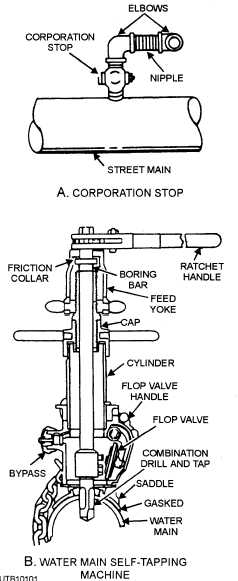trenches. Loose earth free of rocks, broken concrete, frozen chunks, and other rubble should be placed in the trench carefully in 6-inch layers and tamped in place. Care should be taken to compact the backfill under and beside the pipe to be sure the pipe is supported properly. Backfill should be placed evenly on both sides of the pipe and tamped to retain proper alignment. The rest of the trench can be filled using heavy equipment.
SERVICE CONNECTIONS
Service connections, or house sewers (the lines from the house to the street lateral), are often built with concrete, cast iron, or plastic pipe. They should not be smaller than 4 inches in diameter. If a Y or a T branch is not built in at the point where a connection needs to be made, the Y or T saddles can be used. When you are tapping a sewer, extreme care should be taken to prevent breaking the pipe. Ensure the saddle fits well and is cemented firmly to the main line to prevent infiltration. This also helps to keep out roots from trees and other plants. Service connections must not be made by breaking into the pipe. This makeshift method is not watertight and often causes severe damage to the pipe.
Q17. To maintain a 2-foot slope, you must ensure that a 10-inch-diameter pipe has a minimum drop of how many inches per foot?
Q18. Manholes are required every 300 to 400 feet and at what other point on a main sewer line?
WATER DISTRIBUTION SYSTEM
LEARNING OBJECTIVE: Identify water distribution system elements and installation.
The last section of this chapter explains the procedures to be followed for providing a water source. The water-supply system for a building starts from a single source: the water main. In this section, tapping a water main to install a corporation stop and the elements that go into a water distribution system are discussed.
After the trench is dug to the main water line, a corporation stop (view A, fig. 4-35) can be installed while the main is under pressure by using the water main self-tapping machine shown in view B, figure 4-35. A 1-inch tap is the largest opening that can be made while the main is under pressure. Ninety pounds is the maximum pressure that can be tapped against it with a water-tapping machine. You must understand the operation of the machine before attempting to tap a main under pressure. The tap should be located as near to the top of the water main as possible. Clean the rust and dirt from the main at the point where the tap is to be made. Place the machine gasket on the main and mount the tapping machine over the gasket by wrapping the tie chain around the main.
NOTE
Ensure the saddle and the chain are of the correct size. If you attempt to use the incorrect size, the main will cock and the tap will cross thread.

Figure 4-35. - Corporation stop and self-tapping machine.
Continue Reading